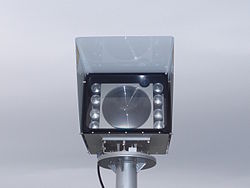Optical Communications in Space
In telecommunications, Free Space Optics (FSO) is an optical communication technology that uses light propagating in free space to transmit data between two points. The technology is useful where the physical connections by the means of fibre optic cables are impractical due to high costs or other considerations.Optical communications, in various forms, have been used for thousands of years. The Ancient Greeks polished their shields to send signals during battle. In the modern era, semaphores and wireless solar telegraphs called heliographs were developed, using coded signals to communicate with their recipients.
Free Space Optics are additionally used for communications between spacecraft. The optical links can be implemented using infrared laser light, although low-data-rate communication over short distances is possible using LEDs. Maximum range for terrestrial links is in the order of 2-3 km, but the stability and quality of the link is highly dependent on atmospheric factors such as rain, fog, dust and heat. Amateur radio operators have achieved significantly farther distances (173 miles in at least one occasion) using incoherent sources of light from high-intensity LEDs. However, the low-grade equipment used limited bandwidths to about 4kHz. In outer space, the communication range of free-space optical communication is currently in the order of several thousand kilometers, but has the potential to bridge interplanetary distances of millions of kilometers, using optical telescopes as beam expanders. IrDA is also a very simple form of free-space optical communications.

Reference links related to this topics
-
Free-Space Optical Communications for Tactical Applications
-
A Brief Overview of Free-Space Optical Communications
-
Optical Wireless Communication using Digital Pulse Interval Modulation
-
FREE SPACE OPTIC COMMUNICATIONS
-
Optical Communications in Space
-
Free-Space Optical communication using visible light
-
Free Space Optical Communications
-
Free-space optical communication


0 comments:
Post a Comment